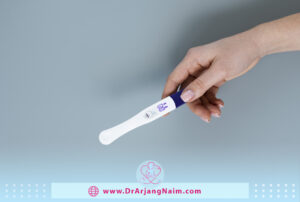Tubal ligation is also known as tubal sterilization or tubes tied. It is a type of permanent contraception. During tubal ligation, the fallopian tubes are cut, tied, or blocked to permanently prevent pregnancy.
Tubal blockage prevents the egg from moving from the ovaries through the fallopian tubes and prevents sperm from moving from the fallopian tubes to the egg. This method does not affect the menstrual cycle.
Tubal ligation can be done anytime, after delivery, or with other abdominal surgery, such as a cesarean section. Most tubal ligation procedures cannot be reversed. If attempted, reversal requires major surgery and is not always effective.
What is tubal ligation?
Tubal ligation, commonly known as “getting your tubes tied,” is a surgical procedure for permanent female sterilization. During this procedure, the fallopian tubes, which are the pathways that carry eggs from the ovaries to the uterus, are blocked, sealed, or cut. This prevents eggs from traveling from the ovaries to the uterus, effectively making it difficult for sperm to reach the egg and for a fertilized egg to reach the uterus.
Tubal ligation is a highly effective method of contraception and is intended to be a permanent form of birth control. It’s usually considered for people who are certain they do not want to have biological children in the future or who have completed their desired family size.
It’s important to note that tubal ligation does not affect a woman’s menstrual cycle, hormone production, or sexual functioning. It only prevents the egg from traveling to the uterus, where fertilization normally occurs.
Reversing a tubal ligation can be possible through a surgical procedure known as tubal ligation reversal, but it’s not always successful, and the success rates can vary based on various factors. It’s essential for individuals considering tubal ligation to carefully weigh the permanence of the procedure and explore other contraceptive options before making a decision.

Why it’s done
Before the fallopian tubes are tied, the healthcare provider will talk with you about your reasons for sterilization. Together, you’ll discuss factors that might make you regret the decision, such as young age or a change in marital status.
You should carefully consider your decision to undergo sterilization. Although tubal ligation has been successfully reversed in some people, this procedure is permanent. People who are unsure they still want children should choose a reversible form of birth control, such as birth control pills, an intrauterine device (IUD), or a barrier method (such as a diaphragm). Your healthcare provider will also review the following with you:
- Risks and benefits of reversible and permanent methods of contraception
- Procedure Details
- Causes and probability of sterilization failure
- Ways to prevent sexually transmitted infections
The best time to perform this procedure (for example, shortly after delivery or in combination with another abdominal surgery, such as a cesarean section). If you do not have a tubal ligation shortly after delivery or during a cesarean section, use birth control methods at least one month before the procedure and use a reliable method until the tubal ligation is performed.
Before the procedure
You may be asked to take a pregnancy test to ensure you are not pregnant.
During the procedure
Suppose you have the tubes tied periodically as an outpatient procedure. In that case, they either insert a needle or incision through the belly button to inflate the abdomen with gas (carbon dioxide or nitrous oxide). A laparoscope is then inserted into the abdomen.
Usually, your doctor will make a second, small incision to insert special instruments through the abdominal wall. Your doctor uses this tool to seal the fallopian tubes by destroying parts of the tubes or blocking them with plastic rings or clips.
If the tubes are tied after a vaginal delivery, the doctor will likely make a small incision below the belly button, providing easy access to the uterus and fallopian tubes. If your fallopian tubes are closed during a cesarean, the doctor will use the incision made for the delivery.
Laparoscopic tubal ligation
Laparoscopy allows the doctor to complete the closure of the tubes by making two small incisions, one in the navel and the other just above the pubic bone.
First, an intravenous line (IV) is inserted into a vein in your hand or arm. You will be given a general anesthetic through an IV to relax the muscles and prevent pain during surgery. A small incision is then made near the navel. A laparoscope, a thin viewing tube about the width of a pencil, is passed through this incision, and the abdomen is inflated with carbon dioxide to make it easier to see your organs.
Then, a surgical instrument is inserted through a second small incision in the pubic hairline, where the fallopian tubes are located and sealed with a tape, ring, or clip. After the doctor seals the fallopian tubes, he removes the laparoscope and uses dissolvable stitches to close the incisions.
Laparoscopic sterilization is usually performed on an outpatient basis and can be performed at any time. Smaller incisions reduce recovery time after surgery and the risk of complications. You can usually leave the surgery center within four hours after the laparoscopy.

Laparotomy
A laparotomy is a more extensive surgery that requires a larger incision in the abdomen and sometimes a day or two of recovery in the hospital. Your healthcare provider will make a two- to five-inch incision in your abdomen, then advance the fallopian tubes through the incision. Next, the tubes are cut and closed using strips, rings, or clamps. Finally, the doctor closes the abdomen with stitches.
Because this is open abdominal surgery, recovery time may take several weeks. This form of tubal ligation is considered outdated and invasive compared to more modern methods, except when it occurs after a cesarean delivery. In that case, the doctor will use the same incision to deliver the baby and perform tubal ligation.
Mini-laparotomy tubal ligation (mini-lap)
Unlike a laparotomy, a mini-laparotomy uses a smaller incision—that’s why it’s called a “mini” laparotomy. This type of tubal ligation is usually done within 24 hours of a natural birth when you are already under epidural anesthesia. However, if you did not receive an epidural during labor, it can also be done under spinal anesthesia.
After the procedure
If gas was used during tube closure, it would be removed after the procedure. You may be allowed to go home a few hours after the tubes are tied. A tubal ligation immediately after delivery usually does not require a longer hospital stay. You will have some discomfort at the incision site. You may also have:
- Dizziness
- Gassiness or bloating
- Shoulder pain
- Abdominal pain or cramping
- Fatigue
Avoid lifting heavy objects and having sex until your healthcare provider tells you it is safe. As you begin to feel better, gradually resume your normal activities. Call your healthcare provider right away if you have:
- Temperature of 100.4 F (38 C) or greater
- Fainting spells
- Severe abdominal pain that persists or worsens after 12 hours
- Bleeding from the wound through the bandage
- Discharge from the wound that has a bad smell
Advantages
Here are some potential advantages of getting tubal ligation:
- Permanent contraception: Tubal ligation is a highly effective and permanent method of birth control, making it a suitable option for individuals or couples who are certain they do not want to have any more children.
- High success rate: Tubal ligation is extremely effective in preventing pregnancy, with a success rate of over 99%.
- No hormonal changes: Unlike other forms of contraception, tubal ligation does not involve hormonal changes or synthetic hormones. This can be an advantage for those who prefer to avoid hormonal contraceptives.
- No ongoing costs: Once the procedure is done, there are no ongoing costs associated with maintaining this form of birth control, unlike methods such as birth control pills, patches, or intrauterine devices (IUDs) that may require regular purchases or replacements.
- Independence from contraceptives: After tubal ligation, individuals can have sexual intercourse without worrying about contraceptive failure or the need for additional contraception.
- Reduced health risks: Tubal ligation may reduce the risk of certain reproductive health issues, such as ectopic pregnancy (outside the uterus) and ovarian cancer.
- Non-hormonal option: For those who cannot or prefer not to use hormonal contraceptives, tubal ligation provides a non-hormonal option for birth control.
- No impact on sexual function: Tubal ligation does not affect sexual function, libido, or the menstrual cycle. It only prevents the egg from reaching the uterus.
- No effect on breastfeeding: Unlike some hormonal contraceptives, tubal ligation does not interfere with breastfeeding.
It’s important to note that tubal ligation is a permanent decision, and while reversal is possible, it is complex and not always successful. Therefore, individuals should carefully consider their family planning goals and discuss the decision with their healthcare provider before opting for this procedure.
What are the disadvantages of getting tubal ligation?
While tubal ligation is an effective and permanent method of contraception, it also comes with several disadvantages and considerations that individuals should carefully weigh before deciding to undergo the procedure. Here are some potential disadvantages:
- Irreversible: Tubal ligation is considered a permanent form of contraception. While it is possible to attempt a tubal ligation reversal or undergo in-vitro fertilization (IVF) for a chance at pregnancy, these options are not always successful, and the procedures are complex and expensive.
- Surgical procedure: Tubal ligation requires a surgical procedure, which carries inherent risks such as infection, bleeding, anesthesia complications, or injury to surrounding organs.
- Not immediate effectiveness: Tubal ligation is not immediately effective in preventing pregnancy. Additional contraception must be used after the procedure until the healthcare provider confirms that the fallopian tubes are fully blocked.
- Limited protection against STIs: Tubal ligation does not protect against sexually transmitted infections (STIs), so if protection from STIs is desired, additional measures like condoms are necessary.
- Regret or change of circumstances: Individuals may experience regret later in life due to changes in life circumstances, relationships, or desires regarding having more children. Reversal of tubal ligation is not always successful, and the decision to undergo the procedure should be carefully considered.

What is post-tubal ligation syndrome?
Not everyone has symptoms of post-tubal ligation syndrome (PTLS). Some common symptoms of PTLS include:
- Pain in the pelvis or back
- Painful sex
- Headache
- Cramps during menstruation
- Abnormal bleeding or no period
- PMS or menopause symptoms
Talk to your doctor if you experience uncomfortable or painful symptoms in the months or years after having your tubes tied. They can help treat your symptoms and rule out any serious complications.
The bottom line
Tubal ligation is a safe and effective permanent birth control method, but it doesn’t work for everyone. Fewer than 1 in 100 women become pregnant in the first year after surgery. The younger you are when you do it, the more likely it is to fail.
If you get pregnant after having your tubes tied, there is a risk of an ectopic pregnancy. If you think you are pregnant after having your tubes tied, call your healthcare provider immediately. Remember that although tubal reversal is possible, the method is complicated and may not work.
Additional questions
- How long does it take to recover from a tubal ligation?
Recovery from a tubal ligation varies but typically involves immediate post-surgery monitoring, with most individuals going home the same day. The first week involves rest and avoiding strenuous activities, gradually returning to normal activities over the next two to four weeks. Pain and discomfort lessen during this time. Full recovery takes several weeks to a couple of months, gradually resuming regular activities, including exercise and sexual intercourse, once the surgical sites have healed. Following post-operative care instructions is crucial, and contact your healthcare provider with any concerns during the recovery period.
- Can a woman get pregnant after tubal ligation?
The probability of getting pregnant after tubal ligation is low. Depending on how the fallopian tubes are closed, the pregnancy rate varies from 0.4% to 1% within 10 years after performing this procedure.
- Where do the eggs go after tubal sterilization?
Your body will continue to release the egg when you ovulate, even though the passage through the fallopian tubes is already blocked. The egg becomes very small, breaks down, and is absorbed into your body.
- What is a Salpingotomy?
Salpingotomy is a surgical procedure involving the incision or opening of a fallopian tube, also known as the salpinx. This procedure is often performed to treat specific conditions related to the fallopian tubes, such as ectopic pregnancy.
- What are three methods for permanent methods of birth control?
- Tubal Ligation
- Vasectomy
- Permanently implanted birth control device for women
References
https://www.mayoclinic.org/tests-procedures/tubal-ligation/about/pac-20388360
https://my.clevelandclinic.org/health/treatments/4933-tubal-ligation
https://www.webmd.com/sex/birth-control/should-i-get-my-tubes-tied
https://www.betterhealth.vic.gov.au/health/healthyliving/contraception-female-sterilisation
https://www.webmd.com/sex/birth-control/what-is-tubal-ligation
https://www.mountsinai.org/health-library/surgery/tubal-ligation
https://www.familyplanning.org.nz/advice/contraception/tubal-ligation




